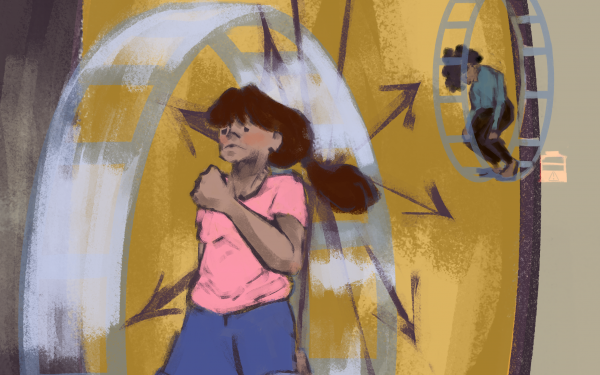Start-Ups Find a Home at Notman House
In an Aging Building, New Technology—and Strategies—Thrive
From the outside, Notman House appears to be nothing more than a dilapidated building just west of the gas station at the corner of Sherbrooke St. W. and St. Laurent Blvd.
But walk through the unassuming door of 51 Sherbrooke St. W. and you’ll find yourself in an entry hall with whitewashed walls and dark wood floors, flanked by workspaces and ending in an elegant—though slightly disheveled—winding staircase.
The space has been quietly occupied for the past two years by a dozen-odd start-ups that rent the few available offices. Those in the know frequent the rudimentary café on the ground floor, and put it to use as a de facto office.
The OSMO Foundation, a non-profit created to the spearhead the Notman project, recently concluded a funding campaign that has permitted it to begin an ambitious—if respectful—renovation of the space, which is designated a heritage building by the city.
The organization has a mandate to support entrepreneurship; the project emerges in tandem with a Montreal start-up community that has been gaining critical mass in recent years.
“The interesting thing about this project is that it’s definitely the only one that I know of in Canada that was really created from the bottom up,” said Gabriel Sundaram, one of the initiative’s coordinating volunteers.
According to Sundaram, in most cities across North America, it is different levels of government wanting to jump-start entrepreneurship that oversee the birth of such cooperative workspaces.
Not at Notman House, however.
“It was a grassroots initiative,” said Sundaram. “The people who are actually using the space are the ones who fought for it to happen,”
As such, the outreach groundwork was laid far before funding campaigns even began. “It wasn’t like we showed up, no one knew about it and they read about the campaign and contributed,” he said.
Thanks in part to the extensive network involved with the Notman House project from its infancy, its crowd-funding campaign turned out to be the year’s biggest Canadian success story on Indiegogo—an online funding platform—raising over $110,000 during its 21-day campaign.
“As soon as we let out the video of the crowd-funding campaign, it just took off. We were blown away by the amount of support,” said Zoe Desroches, another Notman volunteer. “We thought it might have been a bit more difficult to get donations, but it proved to be one of the easier parts.”
The fact that the project started as a pilot helped its cause, Sundaram said. He doesn’t think the initiative would have gotten the support it did with simply a business plan.
“[It demonstrated] there was actual demand for it,” he said. “There were [already] people who wanted to move in and hold events.”
Gabriel Lesperance, chief technology officer of a start-up currently residing in Notman’s attic, is excited about the potential the space has to generate spontaneous encounters and learning.
“Once [Notman] is renovated, we’ll be able to have maybe hundreds of start-ups [under one roof].”
“That’s the spirit here—you exchange ideas, people will talk to you,” said Lesperance. “What makes a [motivating] start-up environment is being able to bounce ideas off people working in the same domain as you. It makes our ideas evolve so much faster.”
“If you have a problem, you can usually just say it out loud and somebody will have a solution,” said Eddy Razar, a non-tenant who can be found working in the Notman café most days.
Sundaram emphasized that no matter where you come from, you can find success as a start-up.
“What you have to do is build a team of people to help fill the gaps where you’re missing skills,” he said. Notman will act as a space for necessary encounters between talents from various backgrounds.
“There’s still a large part of the population that doesn’t consider working at a start-up a real choice,” said Sundaram. “They think they have to work at a bank or some big corporation, or move to Toronto or New York to do something interesting.”
Sundaram—who himself moved to the United States for seven years to look for work after school—hopes that the Notman House will make people feel like there are opportunities available to them right here in Montreal.
The first step in moving forward is to rehabilitate the decaying mansion.
“It’ll be interesting to see what we’ll be able to do once the space gets off the ground,” said Sundaram.
Despite the house’s rugged appeal, the project has gone undeniably high profile, with millions of dollars in funding received from all levels of government on top of Indiegogo pledges.
Sundaram hopes to keep the project “close to the ground” by maintaining stakeholder involvement and making room for new start-ups to thrive. Young start-ups can currently hold events at Notman rent-free.
Funds accumulated from rental fees and events will be funneled back into improving the space through workshops and events that would feed the community by putting them in touch with investors, lawyers and freelancers, in the city and beyond.
“One of my personal focuses is to use Notman as a platform to start reaching out to other cities,” said Sundaram.
The Notman House and the building behind it will be converted into three floors of small office spaces to be rented out at low rates to young start-ups. Desroches said there will be a public café at street level.
“Incorporating common spaces lends to supporting [the goal of building the start-up community]. We’re a very open project and that’s really what we’re looking to help foster,” he said.
Sundaram agreed, saying the evolution of the project will continue with input from the community.
“The steering committee is made of entrepreneurs from the community,” he said. “We have a wiki that people can add comments to. Being web people, we’ll try to leverage technology as much as possible and give people a place to express their opinions.”
So what are the first steps to becoming an entrepreneur? According to Sundaram, it’s simple.
“The first step is walking out of the Hall Building and taking those couple of hundred steps and coming over here.”

01_900_598_90.jpg)
05_900_598_90.jpg)
_600_832_s.png)

_600_375_90_s_c1.jpg)
_600_375_s_c1.png)

